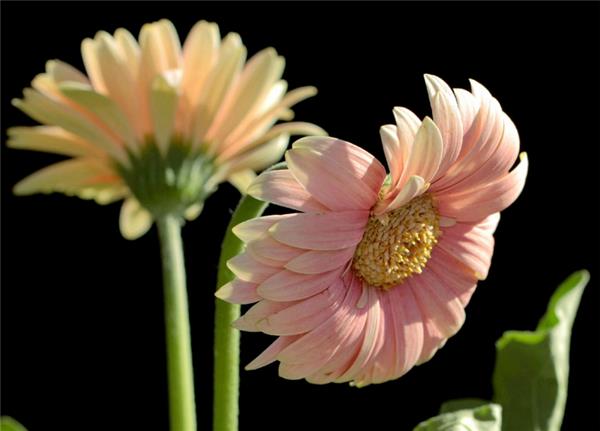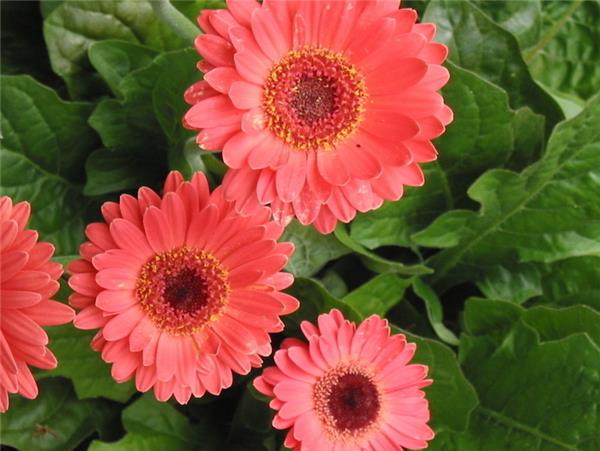Diseases and Control methods of Gerbera jamesonii
African chrysanthemum has large flowers, diverse flowers and bright colors, so many people often raise gerbera as indoor potted plants, but there are diseases in any plant. Today, we would like to share with you the disease and control methods of African chrysanthemum.

Diseases and Control methods of Gerbera jamesonii
1. Stem rot
If the root of African chrysanthemum is moist and poorly ventilated for a long time, it is easy to cause stem rot, once it occurs, the infection is very fast, and untimely prevention and control may lead to devastating disasters.
Prevention and control methods: clean the drainage ditch to lower the groundwater level, remove the old leaves, diseased plants and diseased bodies in time, burn or bury them deeply, and disinfect or change the soil at the disease site.
In the process of growth, sulfur powder can be regularly sprinkled on the soil surface to inhibit the growth of bacteria; high border cultivation and drip irrigation can effectively prevent the transmission of stem rot; prevention should be given priority to, and fungicides should be sprayed regularly. Regularly spray 60% Dysen zinc wettable powder 600x liquid, or 50% Sukeling wettable powder 1500 times liquid, or use 500g of diexamethasone plus 200g of methyl topiramate and 100kg of medium coarse sand, sprinkle around the rhizome for prevention and control, strictly control moisture during treatment, and apply once a week for 3 times in a row if necessary.
2. Cotton blight
Mainly against the underground part of African chrysanthemum, the killed part decayed and gradually disappeared, the rhizome was dark brown and withered, and the disease was easy to occur when the environment was wet. The pathogens were oospores and thick-film spores, which overwintered in the damaged plants or soil.
Prevention and treatment methods: timely removal of infected plants and destruction; infusion of copper and mercury preparation.

3. Sclerotinia disease
Spring invaded the lower part of African chrysanthemum plant, making it gray and dry or skin rot, the damaged part produced white mycelium, and mouse dung-like black sclerotia could be seen inside and outside the stem in the later stage. The pathogen overwintered in sclerotia. The spores spread and spread in spring, and the optimum temperature for the development of the pathogen was 16-25 ℃.
Prevention and control methods: choose loose soil with good drainage to plant African chrysanthemum; plant spacing should not be too dense in order to ventilate and penetrate; avoid rotation with cruciferous crops; immediately remove and burn diseased plants; infuse mercury preparation; spray with 2500 times of 25% chlorhexidine wettable powder, or 1000 times of 50% nonglidine wettable powder, or 800 / 1000 times of 70% methyl topiramate wettable powder.
4. Anthrax
It first appears in the night tip and leaf margin of the old leaves of African chrysanthemum, and then extends to the middle of the leaves. In severe cases, the young leaves and stems will be infected.
Control methods: timely removal and destruction of diseased plants; spray with 800 times of 70% methyl topiramate wettable powder for 2 or 3 times in a row.

5. Virus disease
After the African chrysanthemum was infected, the leaves and veins of the plants lost green or all turned yellow, forming obscure yellow-green spots, and the new leaves became narrow. The markings are not obvious in the high temperature period. The growth of the infected plants was weak, the number of flowers decreased, the quality decreased, and the plants withered in severe cases.
Prevention and control methods: timely removal and destruction of diseased plants; prevention of operational transmission caused by hands and tools; timely elimination of viral vector aphids and shell insects.
6. White silk disease
After African chrysanthemum was infected with the disease, it softened in the form of dark green water stains at first, and then gradually turned brown and died. The surface of the rhizome produces white hyphae and brown millet grain-sized sclerotia. The pathogen overwintered as sclerotia in the soil and was infected by hyphae in the following year. The most suitable temperature for its development is 32-33 ℃.
Control methods: timely removal and burning of diseased plants; replacement of cultivated soil; perfusion with 20-fold stone-sulfur mixture.

7. Downy mildew
The infected African chrysanthemum first showed that the petiole and leaf veins blackened, and then the leaves blackened and rotted. It is easy to occur in the case of high air humidity and poor ventilation.
Prevention and treatment methods: usually pay attention to the ventilation and light transmission of the plant; spray with metalaxyl wettable powder 800 times a week twice a week for 3 weeks.
8. Leaf spot
It is one of the common diseases of African chrysanthemum, which mainly occurs in leaves. The infected leaves began to appear purple-brown spots, and then gradually expanded into round and subcircular lesions, with a diameter of 1mm to 7mm, dark gray in the center, purple-brown edges, black spots on the lesions, and sometimes the lesion tissue cracked to form perforation. The disease of the original chrysanthemum Cercospora, chrysanthemum leaf mold, Alternaria and other fungi. Due to different pathogens, the symptoms are slightly different. The leaf spot caused by Cercospora chrysanthemum has slightly raised brown light lines on the edge of the spot and inobvious dark green mildew spots on both sides of the spot. The disease spot caused by chrysanthemum leaf spot mold has concentric wheel pattern, and there are black dots on it. Generally, the disease is serious under the conditions of dampness, lack of sunlight, soil viscosity and poor drainage, and excessive use of nitrogen fertilizer is easy to cause this disease. The disease began to occur in late May and was serious from July to September.
Prevention and control methods: potted African chrysanthemum should be placed in a sunny and well-ventilated environment, and farm manure should be properly used, or phosphorus and potassium fertilizer should be added to enhance plant disease resistance; at the initial stage of the disease, diseased leaves should be removed in time and destroyed centrally to control the spread and spread of the disease; spray with 50% carbendazim 500 × 600 times, or 70% topazin wettable powder 800 / 1000 times, preferably after removing diseased leaves, to improve the control effect.
Due to different pathogens, the symptoms are slightly different. The leaf spot caused by Cercospora chrysanthemum has slightly raised brown light lines on the edge of the spot and inobvious dark green mildew spots on both sides of the spot. The disease spot caused by chrysanthemum leaf spot mold has concentric wheel pattern, and there are black dots on it. Generally, the disease is serious under the conditions of dampness, lack of sunlight, soil viscosity and poor drainage, and excessive use of nitrogen fertilizer is easy to cause this disease. The disease began to occur in late May and was serious from July to September.
Prevention and control methods: potted African chrysanthemum should be placed in a sunny and well-ventilated environment, and farm manure should be properly used, or phosphorus and potassium fertilizer should be added to enhance plant disease resistance; at the initial stage of the disease, diseased leaves should be removed in time and destroyed centrally to control the spread and spread of the disease; spray with 50% carbendazim 500 × 600 times, or 70% topazin wettable powder 800 / 1000 times, preferably after removing diseased leaves, to improve the control effect.
Related
- Wuhan Hospital Iron Tree Blooming Result Was Instantly Frightened by the Gardener Master
- Which variety of camellia is the most fragrant and best? Which one do you like best?
- What is the small blue coat, the breeding methods and matters needing attention of the succulent plant
- Dormancy time and maintenance management of succulent plants during dormancy
- Minas succulent how to raise, Minas succulent plant pictures
- What are the varieties of winter succulent plants
- How to raise succulent plants in twelve rolls? let's take a look at some experience of breeding twelve rolls.
- Attention should be paid to water control for succulent plants during dormant period (winter and summer)
- Watering experience of twelve rolls of succulent plants
- Techniques for fertilizing succulent plants. An article will let you know how to fertilize succulent plants.



